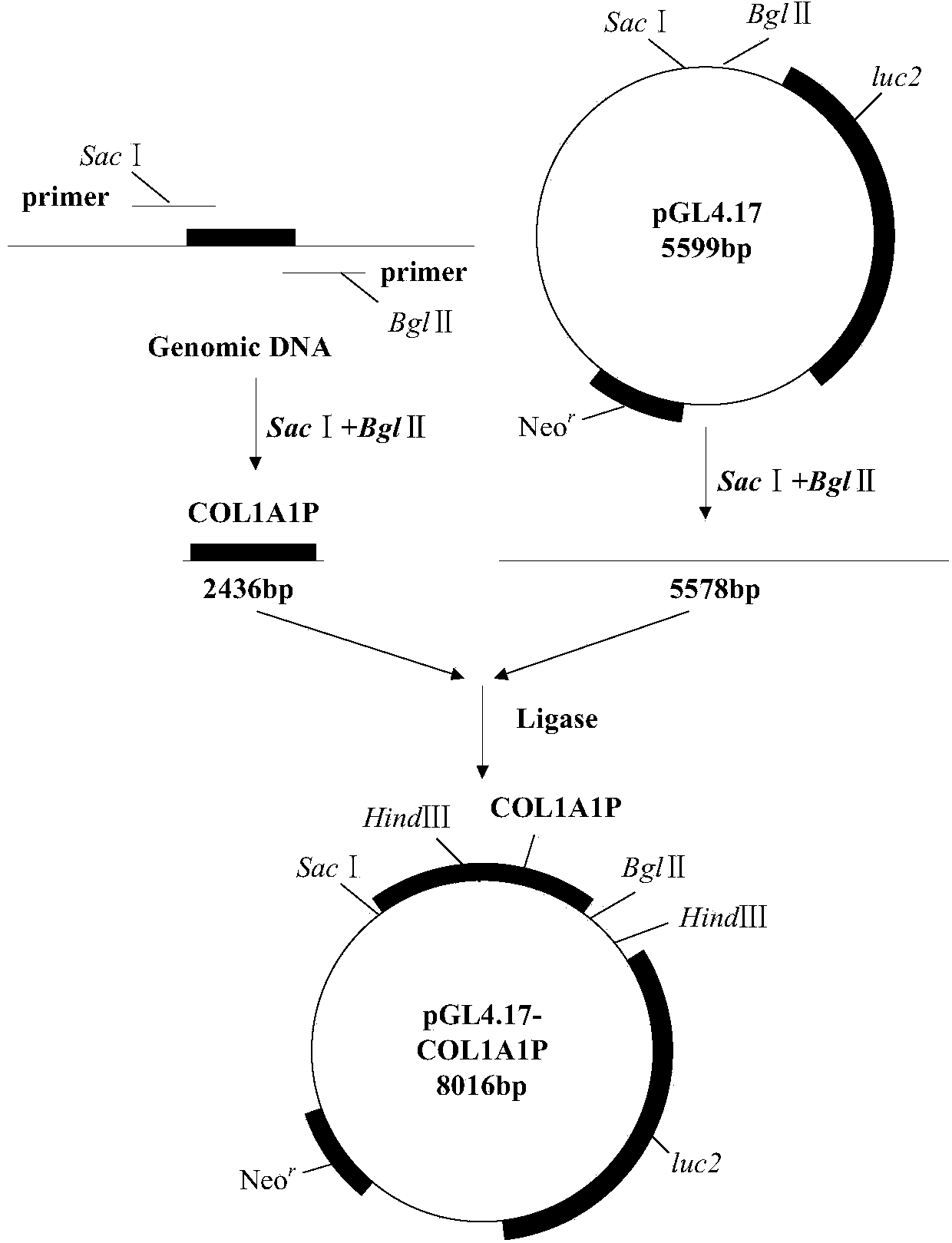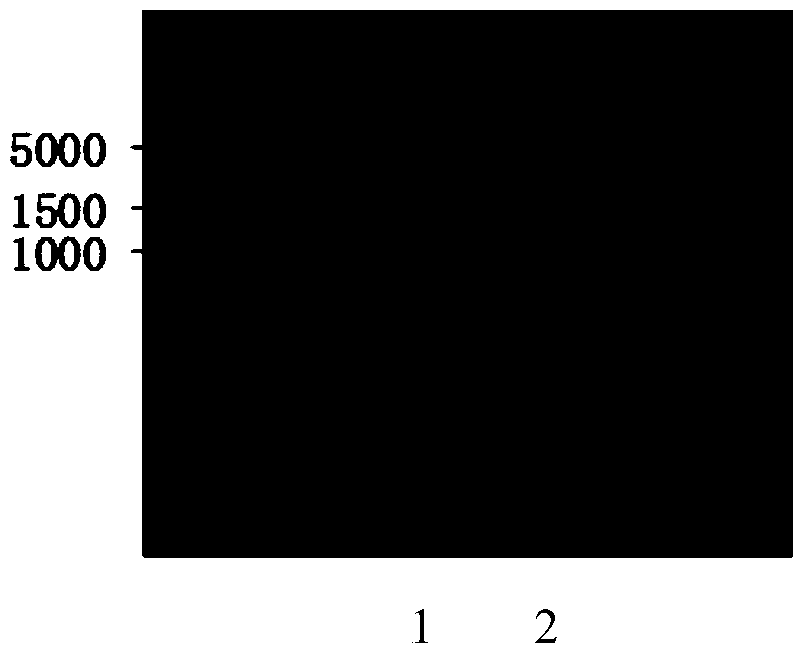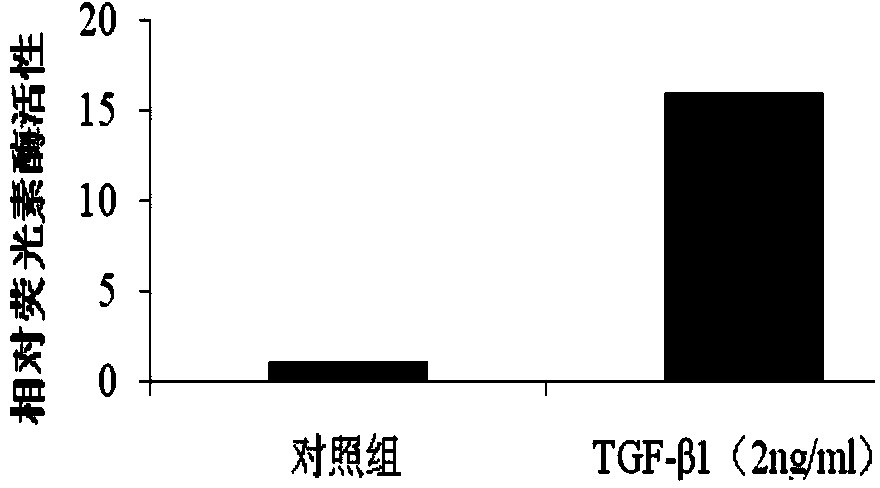Construction and application of anti-hepatic fibrosis drug high-throughput screening cell model
An anti-hepatic fibrosis, high-throughput technology, applied in the assay/inspection of cells, microorganisms, and biological tests modified by the introduction of foreign genetic material to achieve high reliability and adaptability
- Summary
- Abstract
- Description
- Claims
- Application Information
AI Technical Summary
Problems solved by technology
Method used
Image
Examples
Embodiment 1
[0033] Construction of "Example 1" pGL4.17-COL1A1P recombinant plasmid
[0034] Genomic DNA of LX2 cells was extracted using a genomic DNA extraction kit. The first about 2400 bp of the COL1A1 sequence (sequence number: NC_000017.11) of the human whole genome information of the NCBI database human type I collagen α1 gene COL1A1 was used as the COL1A1 promoter sequence. Primer Premier 5.0 was used to design primers for the COL1A1 promoter. The sequences of the upstream and downstream primers were 5'AAGAGCTCGTGGGAAAGCCTGGATGG3' (including the SacⅠ restriction site), and 5'AAAGATCTTTTGGGACTTACTGTCTTCGT3' (including the BglⅡ restriction site). Using the genomic DNA of LX2 cells as a template, PCR amplification was carried out to obtain the target fragment type Ⅰ collagen α1 gene COL1A1 promoter, and the PCR product was initially identified by agarose gel electrophoresis.
[0035] The type I collagen α1 gene COL1A1 promoter fragment was ligated with the pGL4.17[luc2 / Neo] vector af...
Embodiment 2
[0037] "Example 2" screening of monoclonal cell line LX2-COL
[0038] 1. TGF-β1 enhanced COL1A1 promoter activity detection
[0039] LX2 cells (Mount Sinai School of Medicine) were cultured in DMEM (Gibco) medium containing 10% fetal bovine serum at 37°C and 5% CO2. According to each well 5×10 4 Cells were plated on a 48-well plate, cultured for 24 hours, and transiently transfected for 6 hours with the method recommended by the transfection reagent lipofectamine2000 (Invitrogen), wherein the transfection amount of the plasmid pGL4.17-COL1A1P was 100 ng per well, and the internal reference plasmid Renilla was 30 ng per well. Plasmids: liposomes are 1 (μg): 2 or 2.5 (μl), and each experiment set up 3 replicate wells. After TGF-β1 (2ng·mL -1 , R&D Systems)) after 24h induction, the dual luciferase reporter gene detection system ( Reporter Assay System, Promega) detects the fluorescence intensity. Add 65 μl of 1× cell lysate (PLB) to each well, shake at room temperature for...
Embodiment 3
[0042] "Example 3" anti-hepatic fibrosis drug screening and compound activity identification
[0043] 1. Single luciferase reporter gene detection system to screen candidate compounds
[0044] The LX2-COL monoclonal cells were divided into 2×10 per well 4 Cells were plated in a 96-well plate, cultured without serum after the confluence of the cells was about 90%-95%, and TGF-β1 (2ng·mL -1 ) induction, while adding candidate compounds S1-S7 (80μg·mL -1 ), and the compound epigallocatechin gallate EGCG was used as the positive control drug, and 3 replicate wells were set for each group of experiments. After 24 hours of action, the original medium was discarded, and 50 μl / well of any medium was added. Add luciferase substrate (Bright-Glo TM Luciferase Assay System, Promega) 50 μl / hole, and the cell was lysed for 2 min before detection ( Figure 5 ). The results showed that after the compound S7 was added, the fluorescence of the LX2-COL cell line was the weakest, that is, ...
PUM
 Login to View More
Login to View More Abstract
Description
Claims
Application Information
 Login to View More
Login to View More - R&D
- Intellectual Property
- Life Sciences
- Materials
- Tech Scout
- Unparalleled Data Quality
- Higher Quality Content
- 60% Fewer Hallucinations
Browse by: Latest US Patents, China's latest patents, Technical Efficacy Thesaurus, Application Domain, Technology Topic, Popular Technical Reports.
© 2025 PatSnap. All rights reserved.Legal|Privacy policy|Modern Slavery Act Transparency Statement|Sitemap|About US| Contact US: help@patsnap.com



